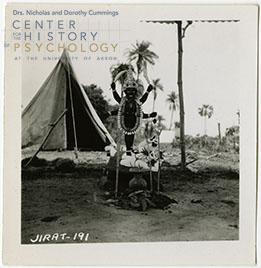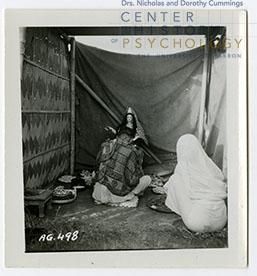contributed by Museums & Archives Certificate Program student Katie Gable
The first film in the Night at the Museum trilogy came out in 2006 and my family rented it from the local Family Video shortly after its DVD release in 2007. Six-year-old Katie watched that film and never let it leave her mind. She knew she would somehow be involved with museum and archival work and fifteen years later, she made this dream a reality.
Though the people in the pictures I looked through never came to life (I attribute that to lack of movie magic), I was given the opportunity to tell their stories and bring them to life through my capstone project.
This project has been an incredible experience. Not only was I given the opportunity to work in the Archives of the History of American Psychology, but I worked under the guidance and in the company of some of the most knowledgeable staff members here.
I spent this semester working as a true archivist would, using the finding aid, searching through boxes, and going down rabbit holes. Though the work often felt tedious, with lots to sort through and many searches leading me to dead ends, I was able to accomplish a lot. An accomplishment I am most proud of is the identification of Indian professors and researchers Pars Ram and H.P. Maiti. My first blog post goes more in depth to this process, but as I reflect upon my achievement, I start to understand how amazing this discovery was. I explained that I was unable to find any photos of these men on the internet, despite being able to find photographs of some of their colleagues. With my discovery people doing future research will be able to know what these men looked like thanks to what I found in the Murphys’ still image collection. This is almost unfathomable to me, a 22-year-old, who has always been able to google anything she wanted and find the answer. With this discovery I am contributing to the answers.
I am also extremely proud of the stories I was able to tell with these images, specifically the stories of the two refugee camps that were studied. To be given the opportunity to go through these photos and understand a fraction of what the Indians in these refugee camps were going through was an extremely heartfelt and gratifying experience. I was able to find photos of the Hindu gods and goddesses they were worshiping and told me about how they were feeling and for what they were praying. By going through these images, I was able to visualize the research they were gathering about social tensions.


This semester I was given the opportunity to learn about and become an expert in a topic using primary sources, something very few people get the chance to do. I am beyond grateful for the ability to tell the story of the Murphys and their trip to India using physical firsthand documentation.
When I was assigned this capstone project, there was an emphasis on storytelling. The still images related to the UNESCO study in India in the Gardner and Lois B. Murphy collection tell many stories about a country trying to piece itself back together, researchers and scholars banding together to fix social tensions and heal the trauma they collectively experienced, refugees trying to start again after being displaced, and many other tales of perseverance and community. My hope is that even though I am finished with this project, myself, or someone just as curious, will revisit and be able to capture all the stories I was unable to share. Until then, I hope the research I conducted is enough to help other researchers in their understanding of the Murphys, Indian Partition, or any other relevant topic I was able to address.
